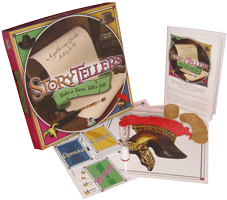

I had two small children at home when I created this game. One was four years old and the other just turned three.
If you don't believe me, go read about them at DaddyTales
I was constantly coming up with new ways to amuse these little guys and one day I found myself introducing them to a game we used to play around the campfire.
The game is very simple: one person starts a story, and each person adds a new line.
They loved it, of course. So I tried playing it with some grown up friends. Suddenly, there were problems. People froze up: "start a story? How do I start a story? Are you nuts?"
So... That was my first decision. I had to provide people with story lines. Once I started adding story lines, I decided that I wanted them to span many genres. They're not all fairy tales. There's modern, western, fantasy, comic book, film noire... a whole lot of genres are represented.
My next decision was to have recurring characters. I really love the way this has worked out in the game. You could be playing the game off and on for two months, and then suddenly get a new story line about a character you already told a story about.
The people at the table (or at least some of them) know the characters' "history" - and will probably refer to the previous story in your new one! Even better, that history is unique to your group. It's a safe bet that those characters will not have that same history with any other group of storytellers on the planet.
That's really, really cool. Talk about creating a bond with people!
We continued to play, and I discovered that usually one or two people drove the story, with the rest adding things like "She stopped and tied her shoe."
That's when the idea of Craft Cards hit me. A lot of people don't think about what goes into a good story. The Craft Cards help the players understand different aspects of storytelling: Performance, Impact, Deeper Meaning, Wordplay, Personal Touch, and Character.
The cards say things like "play this card when the StoryTeller names a celebrity you recognize" or "play this card when the StoryTeller effectively changes the mood of a story".
The key to the Craft Cards, of course, is that they are optional and non-intrusive. If a player has a card he just doesn't want to deal with, then he can ignore it. None of the other players will ever know.
Once I had the Craft Cards and the Story Lines, I was 90% of the way home.
The Bravo Chips and Awards are natural additions. How can you have a storytelling game without having a meaningful way of applauding each other?
That would be like sitting down to a dish of melted ice cream - sure it's ice cream, but it's not very appetizing.
Ah... The Hats! That is the biggest question of the game. The first thing to realize is that we needed a non intrusive way for people to keep track of their scores. I didn't want players moving pegs, stacking chips, or anything else that distracts from the experience.
The second is less tangible. To me, when I play this game I forget that I'm in a house. That sounds weird, but it really does feel like you're sitting around a camp fire, a street corner, or even a bar. It feels more intimate and less prepared than a regular game.
What do you have wherever you go? A hat. Well, you also have shoes, but that would have been nasty.
Also, I like the imagery of hats. It reminds me of performers busking on street corners. Put your hat out, give a good performance, and walk away a winner.
That's what it's all about, right?